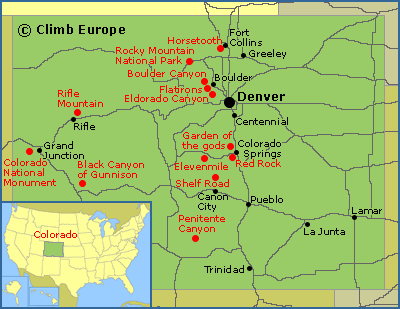Rock climbing and bouldering in Colorado
Colorado is very mountainous state with its state capital, Denver, being exactly 1 mile above sea level (1,609m). The rock climbing in Colorado is incredibly varied with many excellent crags and areas offering everything from bouldering to big walls with alpine cliffs, sport climbing and a wide range of tradition climbing in some of the deepest canyons in America.
Big wall and long multi-pitch routes are found in the Rocky Mountains National Park (alpine style routes on granite rock) where there are more than 250 climbing areas and 55 peaks more than 14,000’ tall (over 4,000m).
Boulder probably has more climbers per capita of population than virtually any other city in the world. There is a good reason for this due to the abundance of quality climbing literally on the door step of the city.
Map of the best rock climbing, sport climbing and bouldering areas in Colorado

Rock climbing at Boulder Canyon
Boulder Canyon is 14 miles long and provides numerous granite crags, buttresses and domes with cracks, steep faces and slabs. The climbs here range from one to four pitches long with both bolted sport climbs and traditional routes. Buy the Boulder Canyon rock climbing guidebook from our shop.
Rock climbing at Flatirons
Just to the south of Boulder are the 350m high sandstone and conglomerate crags at Flatirons. The routes here are generally slabby but have a reputation for being of a serious nature due to the sometimes sparse gear placements.
Rock climbing around Colorado Springs
There are numerous rock climbing areas close to the city of Colorado Springs, with Garden of the Gods and Red Rock Canyon being the closest. Garden of the Gods offers sandstone climbing up to 100m high, with routes being from 1 to 5 pitches long. Most of the routes are protected with pegs (pitons) though these are slowly being replaced with bolts and there are a smaller number of traditional routes. Red Rock Canyon is the largest climbing area in the Pikes Peak region, which provides a marvellous sport climbing area. The vast majority of the routes are single pitch on sandstone rock. To the west of Colorado Springs is Elevenmile Canyon with numerous granite crags ranging from 15m to 150m high, along the 9 mile canyon. Many of the routes are bolted though there are also some traditional routes as well. Other sport climbing areas include Penitente Canyon (Volcanic) and Shelf Road (limestone) that are to the south of Colorado Springs.
Shelf Road is recognised as one of the best sport climbing venues in America that boasts over 1,200 routes from 5.4 (F4) to 5.14 (F8c). The sport climbing at Shelf Road is on a series of limestone cliffs and canyons with predominately single-pitch routes on vertical to slightly steep rock. Buy the Shelf road rock climbing guidebook from our shop.
Rock Climbing at Eldorado Canyon
Eldorado Canyon is just 8 miles south of Boulder and is one of Colorado’s oldest climbing areas. Here the sandstone routes are up to 300m long that are generally steep face climbing with edges and incut holds. All the routes are climbed using traditional gear though numerous pegs (pitons) also exist. Just to the north of Boulder, near Fort Collins, is Horesetooth Reservoir, which is the Colorado’s premiere bouldering area.
The Colorado Bouldering Front Range Guidebook is a comprehensive bouldering guidebook covering over 1750 problems from Fort Collins to Colorado Springs, including Horesetooth Reservoir.
Rock climbing in Western Colorado
The rock climbing in western Colorado is dominated by Black Canyon on the Gunnison National Park and Rifle Mountain – two totally different climbing experiences.
Black Canyon on the Gunnison National Park is a very deep and narrow canyon and as such is an intimidating, but beautiful place. To climb these canyon walls requires a high level of commitment and is a forbidding place for any rock climber. Most of the routes are long and complicated but offer adventure climbing at its best – a combination of rock climbing and mountaineering on big remote walls.
Rifle Mountain by contrast is considered as one of America’s premiere sport climbing destinations. Here the overhanging limestone walls offer the largest concentration of hard routes from 5.12 (F7a) to 5.14 (F8c) in the United States. There are over 400 routes here ranging from very hard to easier routes that are suitable for novice and intermediate climbers. Rifle Mountain is a popular place to climb and has easy roadside access.